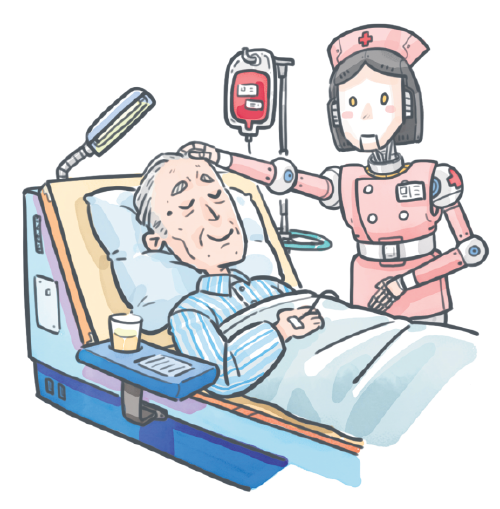Tech prescription for eldercare
By YUAN YOUWEI | China Daily Global | Updated: 2020-09-30 11:06

China can borrow from Japan's experience in using robots to provide medical and nursing care for the aged
The Japanese government has been striving to improve its medical and nursing care and lead relevant high-tech applications globally, something essential in a developed country with the world's most severe aging problem.
One of the greatest challenges for the country is the rising demand for healthcare practitioners. According to the Japanese government, aging people will need nearly one-fifth of the workforce engaged in healthcare by 2040, when the number of people aged over 100 in Japan is likely to reach 300,000.
The various needs of the elderly call for the diversification of medical care services. By 2030, the number of elderly people in cities will increase dramatically, while that in the countryside will decline by nearly 15 percent, thus widening the age gap in urban and rural areas.
Going high-tech is the key to caring for the growing elderly population. The Japanese government has set out three goals-building intelligent infrastructure, meeting personalized needs and forging a sense of community among the aged. That will create an environment where telemedicine and other services can be optimized using artificial intelligence and other programs. With the help of professional guidance, senior citizens can better understand their health condition and choose health services suited to their needs. Also, senior citizens can support and help each other by becoming part of a network. They will be assisted by cloud services and robots adjusted according to the environment changes and personal demands.
Since 2013, the Japanese Ministry of Economy, Trade and Industry, and the Ministry of Health, Labour and Welfare have emphasized developing nursing robots, leading to policies being refined.
The government is also committed to promoting information and communication technology in medical care. By setting standards and norms for information cooperation between companies and nursing institutions, it is helping improve efficiency and coordination.
Japan's nursing industry for elderly citizens has been developed on the basis of a concrete outline. In April 2019, the Ministry of Health, Labour and Welfare released a report on promoting the development of information and communication technology and operational efficiency in nursing. The report proposed concrete implementation plans for health, medicine and nursing. Moreover, the healthcare industry has also established a group to review and revise the Cabinet's documents, examine the need for technology research and development, and promote new technologies' social application.
To regulate the application of information and communication technology in nationwide nursing institutions, the Japanese government created a standard for information management and medical care institutions in 2018. It formulated safety standards in nursing institutions in the fiscal year 2019.
China can learn from Japan's experience.
The Chinese government and relevant companies can borrow from Japan's experience in supporting the R&D of robots and information and communication technology for eldercare, which focuses on improving financial support for the high-tech industry.
Japan's experience shows that government policy and financial support are the foundations for high-tech application and information exchanges, offering references for the Chinese government.
In recent years, the Chinese government has made comprehensive plans to improve the technological level of senior citizen-related healthcare. And it has made greater efforts to accelerate this process by vigorously promoting the Internet Plus model in medical care and nursing services for the elderly.
But governments at all levels should coordinate and provide financial support. Both the Japanese central and local governments have increased spending to accelerate relevant technologies and equipment for nursing robots. The central government contributed two-thirds of the investment while local governments paid one-third. The latter have also set up regional medical funds to support the introduction of nursing robots in regular facilities. Since 2018, the maximum aid for each device has increased from 100,000 yen ($949) to 300,000 yen, with a subsidy rate of 50 percent.
The Japanese government has supported the development of information and communication technology in nursing institutions using medical insurance. The subsidies for the cost of software and tablet terminals are provided by the local government. Each nursing agency's subsidy is limited within 50 percent of its total cost and cannot exceed 300,000 yen.
Since 2018, China's central government has invested 3 billion yuan ($439.8 million) annually in medical care facilities. Besides, 960 million yuan has been drawn from lottery revenue each year for the related projects.
The Chinese government should also work on other problems such as insufficient government guidance and lack of investment in the initial stages of R&D to arouse the enthusiasm of enterprises in R&D. Also, it is necessary to standardize relevant regulations to improve the adaptability and quality of products.
In addition, companies and nursing institutions should be encouraged to participate in the research process. In Japan, the government and private research institutes have worked together. Enterprises highlighting R&D have cooperated with the nursing agencies and established councils to meet their needs better.
And guided by experts from the beginning, the two sides can put forward suggestions for developing nursing robots based on local demand.
When products are introduced in the market for trials, experts can demonstrate the application. Finally, they can be promoted through various channels, such as robot displays, visitor experience, renting, and seminars.
Learning from Japan's practice, China can also help build a cooperative connection between nursing agencies and enterprises and create a sound ecosystem for R&D to promote the development and application of high-level technologies and products in the field of nursing.
The author is the deputy director of the Department of External Affairs at the China Center for International Economic Exchanges. The author contributed this article to China Watch, a think tank powered by China Daily. The views do not necessarily reflect those of China Daily.
























